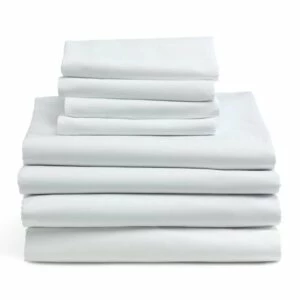Hospital Sheets
Choosing the right bed linens for care facilities is an important decision. Quality bed linens ensure the linens’ longevity and the patient’s comfort. Those in charge of selecting bed linens for care facilities must consider several factors, including the facility’s budget, the environmental conditions, and the population serviced.
When selecting the right hospital sheets for care facilities, the most important considerations are durability and comfort. Durability is essential for sustained usage, as the linens must be washed frequently in commercial-grade machines to meet hygiene standards. Comfort is also key; patients should be offered a comfortable place to rest in a care facility, which means the linens should be soft, smooth, and breathable.
The size and type of bed linens also need to be considered when selecting. Care facilities generally contain beds of standard sizes, and bed sheets come in various sizes. It is important to select the right fit to achieve maximum comfort and avoid needing constant adjusting and remaking of the beds.
When choosing bed linens for care facilities, it is also essential to consider infection control. Easy-to-clean, tear-resistant fabrics that don’t allow the growth of bacteria and other germs are ideal. If a facility is subject to moisture and staining, selecting fabrics that can be washed at high temperatures and colors that don’t show dirt easily is best.
Fitted vs. Flat Sheets: Which is Better?
When choosing bed linens for a care facility, there is one key decision to make: should you select fitted or flat sheets? Both options have pros and cons, and the best choice will ultimately depend on the facility’s needs and the patient’s comfort level.
Fitted sheets are the most common option for care facilities due to their snug fit and simple maintenance. Hospital Fitted sheets contour to the mattress and stay put, eliminating the need for frequent adjustments. They are quick and easy to put on and remove, and the elastic edges keep dust and allergens from entering the bed. On the other hand, fitted sheets do not offer as much coverage as flat sheets, as they do not tuck underneath the mattress and leave a portion of the mattress exposed.
Flat sheets, on the other hand, offer more coverage than fitted sheets as they easily tuck underneath the mattress. This results in a more layered and luxurious look that can make a room more inviting. Flat sheets also protect the mattress, as they offer greater protection against dust, dirt, and allergens. Though they take more time to put on and off the bed, they can be combined with fitted sheets for a complete look. However, flat sheets tend to slide off the bed and require frequent adjustments.
Ultimately, choosing between fitted and flat sheets is a matter of preference. When selecting bed linens for care facilities, considering the facility’s budget, the environmental conditions, and the population serviced can help make the best choice for the facility.
Draw Sheets: Uses and Benefits
Draw sheets are versatile pieces of bedding that provide various benefits. Depending on the type of care facility, draw sheets can offer an extra layer of comfort, ease of use, and hygiene.
At a care facility, hospital draw sheets can be used as a top layer of bedding. They provide an extra comfort layer, are hygienically removable when needed, and can be reused after laundering without losing any fit. Draw sheets are ideal for elderly patients susceptible to incontinence, as their waterproof barrier can catch any liquid spilled onto the bed.
Draw sheets can also provide more coverage than a regular fitted sheet. The extra length at the foot end of the draw sheet can be tucked underneath the mattress for extra coverage, protecting the patient from drafts. It also adds luxury to the bed as the flat-folded bottom can be styled differently.
Draw sheets can also be used alongside regular fitted and flat sheets. By being placed over a fitted sheet, the draw sheet can keep the mattress free from dust and dirt, while the flat sheet can add a decorative touch.
In short, draw sheets provide increased comfort, ease of use, and hygiene at care facilities. From added coverage and protection to a stylish appearance, draw sheets are essential to any bedding ensemble. With the right combination of fitted and draw sheets, care facilities can ensure that their patients receive the best comfort.
Thread Count Importance for hospital & care facilities
When creating comfortable bedding for hospitals and care facilities, thread count plays an essential role. Thread count is the total number of threads woven together in a square inch of fabric. Counted in terms of thread count per square inch (TPI or TPI), the higher the thread count, the denser and more luxurious the fabric will be.
Thread count is typically divided into two categories: the T-130, which counts the number of threads in both the length and width of the fabric and the T-180, which only counts threads in the width of the fabric. The higher number indicates a higher thread count, resulting in a softer and more luxurious feel.
At a basic level, the thread count of fabric determines its comfort. But rest assured; thread count can contribute to more than coziness – its importance reaches far beyond.
First, materials with higher thread counts are typically more durable and longer-lasting, which is essential for a hospital and care facility setting. Second, thread count is associated with absorbency – the higher the number, the greater its absorbency rate, a golden benefit for any care center.
A higher thread count also indicates increased breathability for the fabric. This helps create a cooler sleeping environment and better transfers moisture away from the body.
Finally, the thread count unique ability to create a “silky” sensation also means that higher thread count materials are less prone to pilling and snagging, and this makes them popular for long-term use.
When selecting the ideal bedding combination for any given bed, thread count should be the first consideration. In hospital and care facilities, where comfort, durability and safety are of utmost importance, choosing the right thread count is even more important. Proper thread count ensures that the patient’s sleep is comfortable and safe.
2023 Best Wholesale Waist Aprons | Towel Depot

Wholesale Waist aprons are a type of clothing that is worn around the waist to protect the clothing underneath. They are commonly used by chefs, servers, bartenders, and other food service professionals. They are typically made of durable materials such as cotton or poly-cotton blends and come in various colors and styles to suit different preferences and needs.
4.46

























